How to Choose the Best Woodworking Chisels
A Woodworker’s Guide for Choosing the Best New and Vintage Woodworking Chisels
![]() By Joshua Farnsworth | Updated Mar 01, 2022 (Originally published Dec 02, 2013)
By Joshua Farnsworth | Updated Mar 01, 2022 (Originally published Dec 02, 2013)
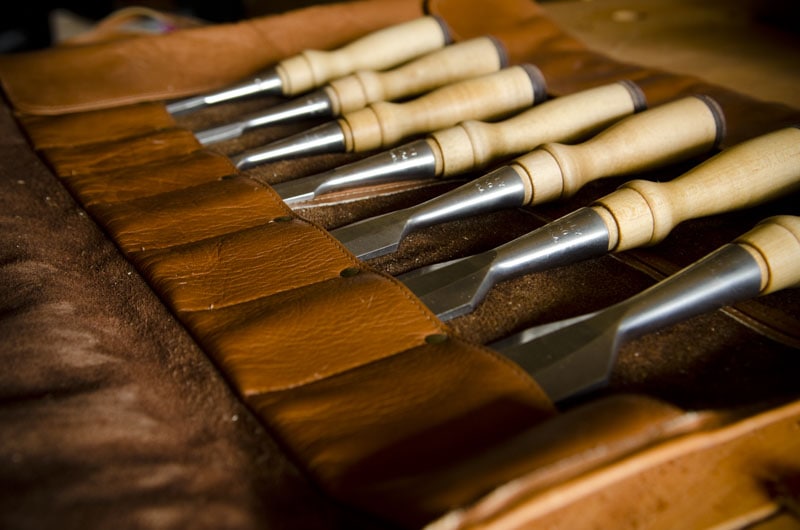
How to Choose the Best Woodworking Chisels

A Woodworker’s Guide for Choosing the Best New and Vintage Woodworking Chisels
![]() By Joshua Farnsworth | Updated Mar 01, 2022 (Originally published Dec 02, 2013)
By Joshua Farnsworth | Updated Mar 01, 2022 (Originally published Dec 02, 2013)
Disclosure: WoodAndShop.com is supported by its audience. When you purchase through certain links on our site, we may earn a small affiliate commission, at no cost to you. Learn more.
Introduction to Buying Woodworking Chisels
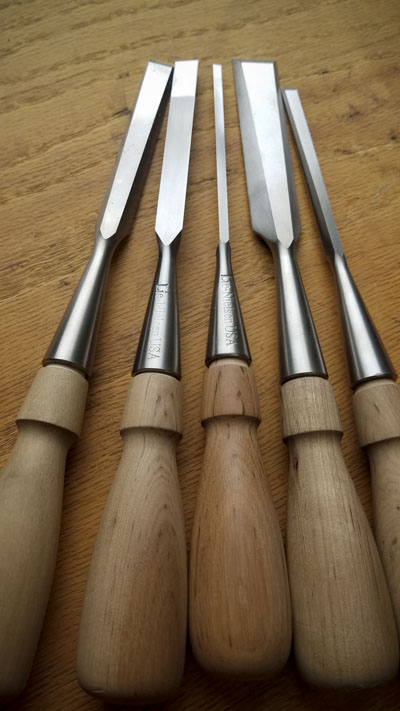
In this article I’ll first answer these four questions:
1. “What is a Woodworking Chisel?”
2. “What are the Best Brands of Chisels?”
3. “What are the 3 Main Types of Woodworking Chisels?”
4. “What type of Chisel Handle is Best? Socket Chisels or Tang Chisels? Wooden or Plastic?”
Then further down, in the Chisel Buyer’s Guide section, I’ll share advice on which woodworking chisels you absolutely need to get started in hand tool woodworking, which ones can wait until later, and which woodworking chisels you likely won’t need.
1. What is a Woodworking Chisel?
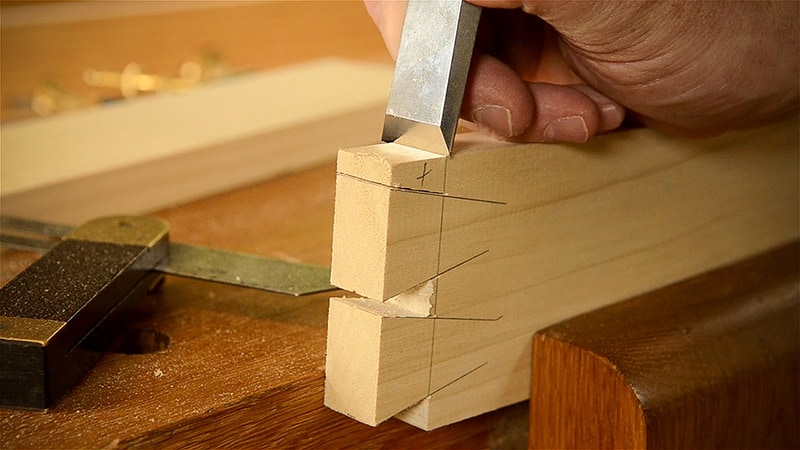
A woodworking chisel (or wood chisel) is basically a sharp angled piece of steel with a handle. It’s impossible to make fine furniture without at least one good wood chisel. And a wood chisel set is even more helpful.
Woodworking chisels are used for so many different steps in making wood joints. And it’s easy to spend way too much money on the wrong woodworking chisels. In this article I’m going to help you avoid that, and buy the best wood chisels for your budget.
2. What are the Best Brands of Woodworking Chisels?
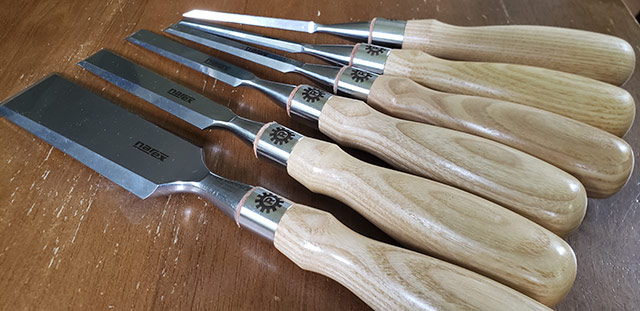
What are the best wood chisel brands? This list of vintage and modern woodworking chisel makers will help you search for quality western-style bench chisels, mortise chisels, and paring chisels (sorry, I’m not listing Japanese chisels). The brand names below are linked to eBay & other searches so you can compare prices & models.
Certain brands may not always be listed on eBay, so check back from time-to-time. Some of these recommendations have come from Wood And Shop readers (I couldn’t possibly find or try out all the chisel brands). Please let me know if I’ve missed any that you love:
- Addis Chisels
- Ashley Iles Chisels
- Barr Chisels
- Beaver Chisels
- Blue Spruce Chisels
- Buck Bros. Chisels
- Butcher Chisels
- Dastra Chisels
- Disston Chisels
- D.R. Barton Chisels
- Erik Anton Berg Chisels (E.A. Berg)
- Eskilstuna Chisels
- Freud Chisels
- Fulton Chisels
- Greaves Chisels
- Greenlee Chisels
- Harold & Saxon Chisels
- Henry Taylor Chisels
- Herring Chisels
- Hibbard Spencer Bartlett Chisels (H.S.B.)
- Ibbotsons Chisels
- IBC Chisels
- J.B. Addis & Sons Chisels
- James Swan Chisels
- L. & I. J. White Chisels
- Lie-Nielsen Chisels
- Marples / Record Chisels
- Mathieson Chisels
- Narex Richter Chisels (my new favorite modern chisels)
- Pfeil Chisels
- R. Timmins and Sons Chisels
- Ray Iles Chisels
- Robert Sorby Chisels
- Stanley Chisels (antique version)
- Stormont Chisels
- Stow & Wilcox / Peck, Stowe & Wilcox Chisels
- Swan Chisels
- T.H. Witherby Chisels
- Titan / Stanley Titan Chisels (made in Tasmania)
- Toga Chisels
- Ulmia Chisels
- Underhill and Peck Chisels
- Union chisels
- Veritas PM-V11 Chisels (Lee Valley)
- Ward Chisels (later Ward & Payne)
- Winsted Edge Tool Works Chisels
- Am I missing any??? Email me to add other favorite!
Don’t stop reading! Below, in the chisel buyer’s guide section, I talk about specific models, sizes, and styles of chisels you need and which you don’t! I also share some of my favorite new chisel sets:
3. Three Main Types of Woodworking Chisels: Bench Chisels, Mortise Chisels, & Paring Chisels
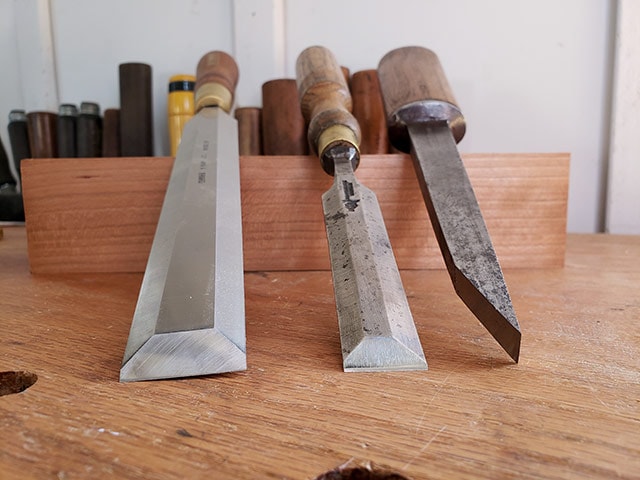
Before you scroll down to my woodworking chisel buying guide, I want to simplify a couple things about wood chisel types. The main type of wood chisels that you’ll want to buy when first getting started in traditional woodworking are bench chisels, mortise chisels, and paring chisels. There are other specialty chisel, like Japanese chisels, carving chisels & gouges, wood turning chisels, fishtail chisels, dovetail chisels, etc. But we’ll talk about those specialty chisels later. In this article, I’ll mostly on basic woodworking chisels. Here are the basic three types of woodworking chisels:
PARING CHISELS
Paring chisels are more delicate chisels used for paring, or careful slicing of the wood. Paring chisels have thinner steel and are usually sharpened with a low angle to aid in paring end-grain and other difficult grain. Paring chisels should never be struck with a mallet, but only used with the hands.
4. Wood Chisel Handles: Which Style and Material is Best?
Woodworking chisel handles come in different styles and different materials. Which is the best? I’ll answer that below…

“Socket Chisels” or “Tang Chisels”?
Woodworking chisels have to be attached to their handles so you can work with them. They are manufactured to attach by either a “socket” or “tang”. A socket chisel has the cone-shaped chisel handle fit into the metal socket of the chisel. Tang chisels have a pointed metal tang that is fastened inside the wood chisel handle:
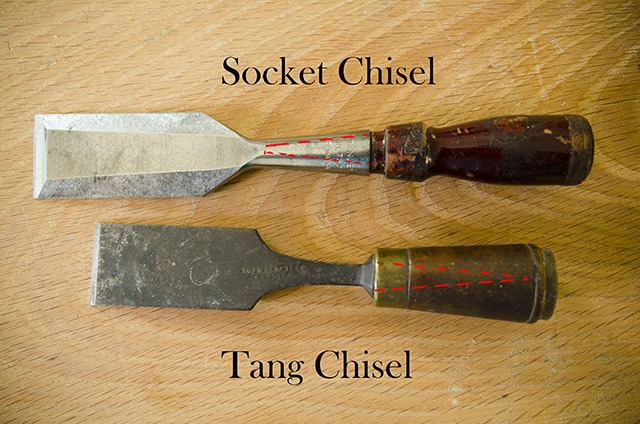
Why are socket handle chisels more expensive than tang handle chisels? Socket chisel handles are more durable than tang handles, and so they are more popular.
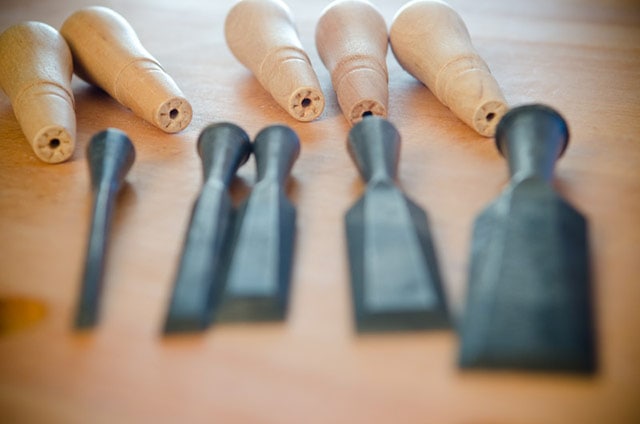
Socket chisels sit on top of the handle’s cone and can take a severe beating, whereas Tang chisels sit inside a handle’s mortise and can split the wood handle if repeatedly struck hard enough with a mallet.
When you see a broken chisel handle, it is usually a tang style. However, tang handle chisels aren’t as fragile as you may think. I own dozens of tang handle chisels and dozens of socket handle chisels, and I have never split a handle on either type.
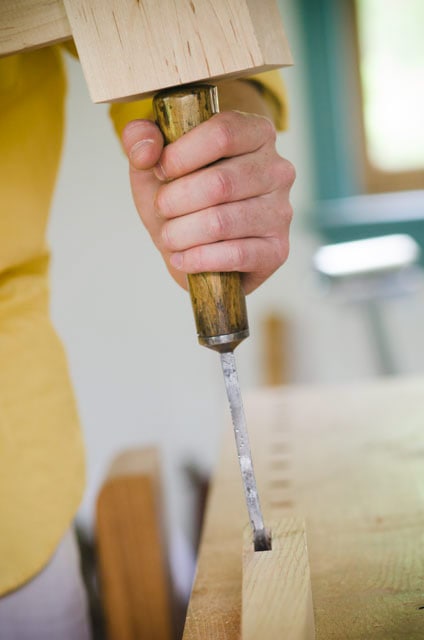
Chisel handles usually break when they are struck with an unreasonable amount of force. This often happens when someone strikes a wood chisel with a metal hammer. You should only ever strike a chisel with a wooden mallet. I teach my woodworking students to chop sparingly with a bench chisel, and to not keep pounding a chisel after it has sunk deep into the wood.
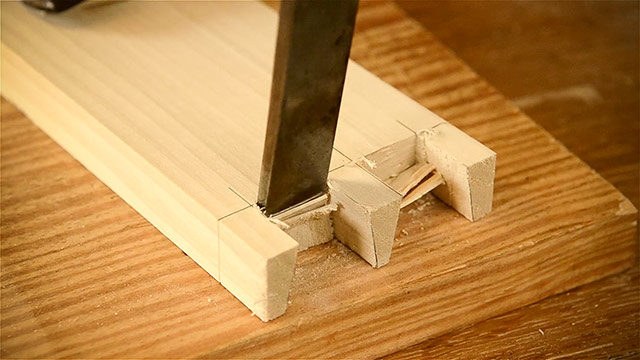
Chop a little way down, clear the waste, then return to chopping. I give this advice even for mortise chisels. Bench chisels usually shouldn’t be used to chop mortises, and when being used to chop dovetails, I stop hitting the chisel when too much resistance is met.
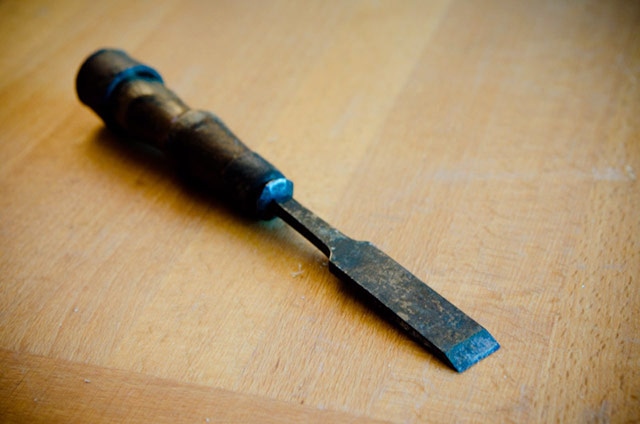
Above you’ll see an antique tang handle chisel that is a prime candidate for rehabbing and sharpening. It’s hard to go wrong buying an antique chisel, tang or socket style. Either style should work just fine if treated well.
Woodworking Chisel Handles: Wood or Plastic Handles?
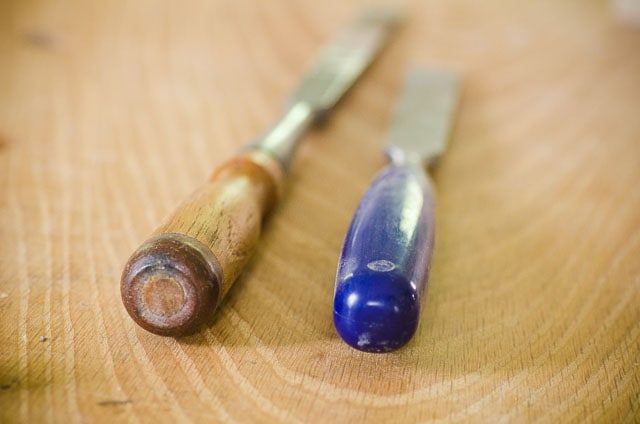
Chisel manufacturers make woodworking chisels in both wood handles and plastic handles. Not surprisingly, I prefer wooden handles. Why? Because of the balance that wood gives to the chisel, and also because of the amazing feel and look.
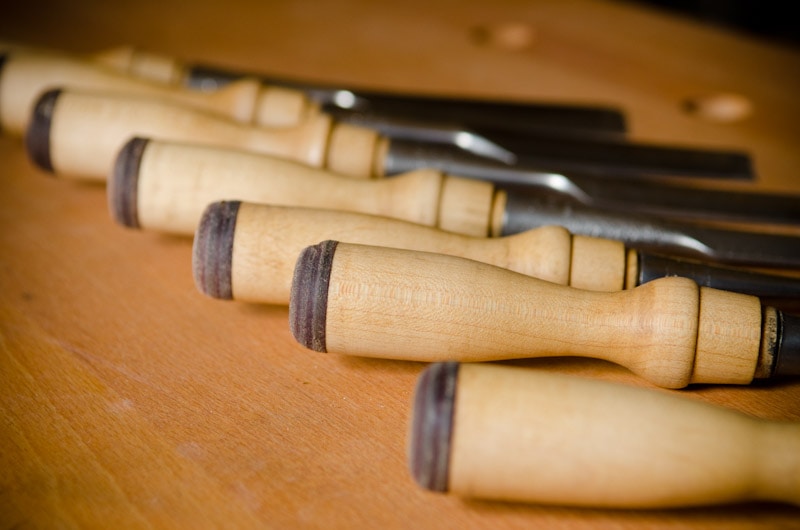
Top-heavy plastic handle chisels can be a tad cumbersome to use. They also don’t feel as good in the hand of most furniture makers. But for the budget-conscious new woodworkers, I’ll also include a good plastic handled woodworking chisel set below. Plastic handles most certainly hold up better to repeated blows. But because you would never use a metal hammer to strike a chisel handle (you would use a wooden joiner’s mallet) it takes a very long time to break a wooden chisel handle.
Woodworking Chisel Buyer’s Guide
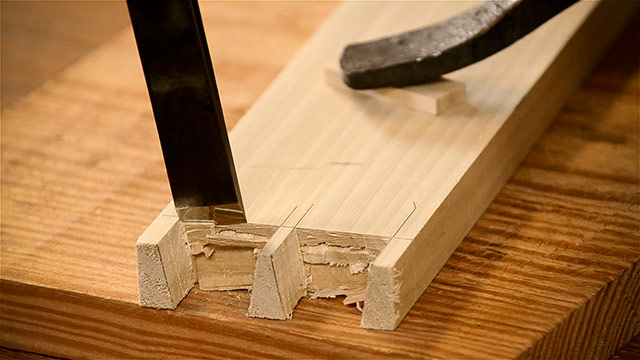

A. Urgent Wood Chisels (Buy these First)
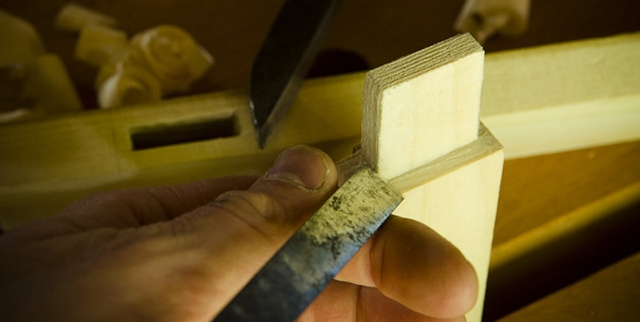
Below is my list of woodworking chisels that I feel would be the first wood chisels that you should buy to get started in traditional woodworking. Other woodworkers may have slightly different priorities and terminology, but these are the basic hand woodworking tools that I recommend.
Buy 4+ Bench Woodworking Chisels
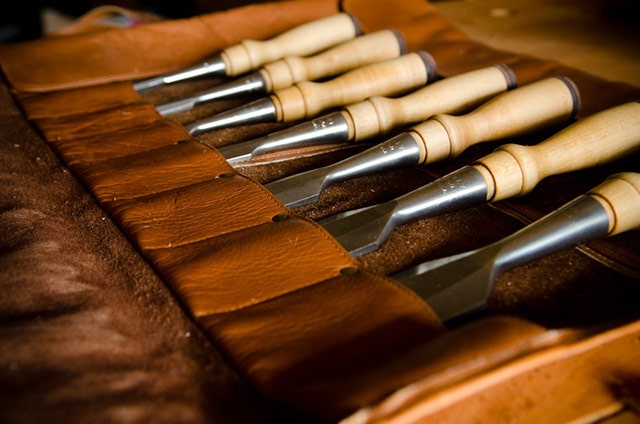
The first woodworking chisels that I recommend that you purchase are bench chisels. Bench chisels are the most common type of woodworking chisels because you use them for so many woodworking tasks. They’re called bench chisels because they’re usually on your workbench, just like “bench planes”.
Bench chisels can either have beveled edges or normal, flat edges. The “bevel-edge” means that the sides move up at an angle to allow the chisel to fit more easily into joints (especially dovetail joints). This is the most common style of chisel, but I like the straight chisels as well (sometimes referred to as “registered chisels or firmer chisels”).
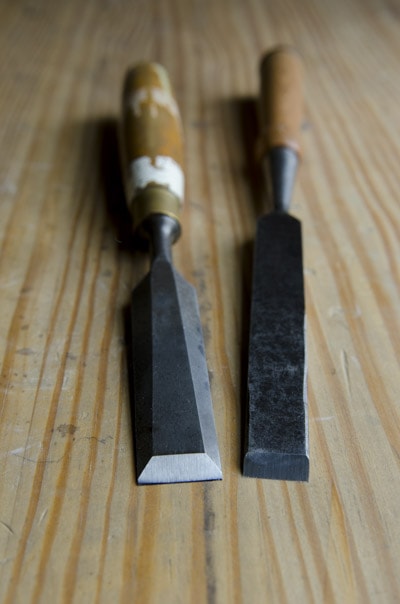
You can either buy a wood chisel set with five to ten bevel-edge bench chisels, or acquire different antique bench chisels in the common sizes. Yes, sets look nice and uniform, and I have several chisel sets, but you don’t always see the old school furniture makers with a shiny set of matching chisels. You see their chisel racks filled with random antique chisels, and their furniture doesn’t show a difference! Here are my chisel racks with a lot of mixed and matched antique wood chisels:
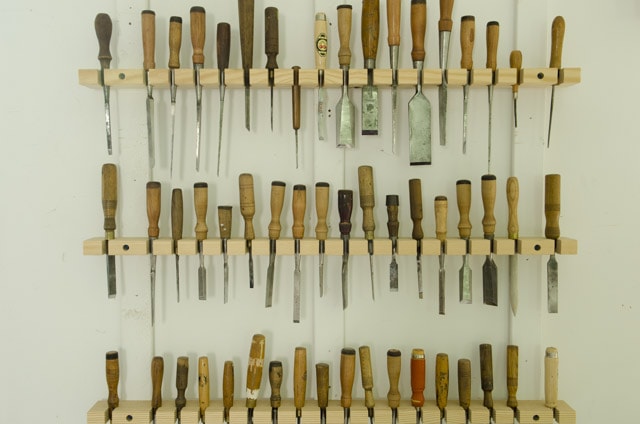
I have purchased many antique woodworking chisels, and the quality of steel is almost always superior to what comes in modern woodworking chisels. It’s like tool steel manufacturing processes were universally understood before World War II, which resulted in amazing chisels that hold an edge well, and then it’s like everyone lost the instructions in the hysteria of mass power tool production. And it seems like only a small number of manufactures have rediscovered the process to make great tool steel again.
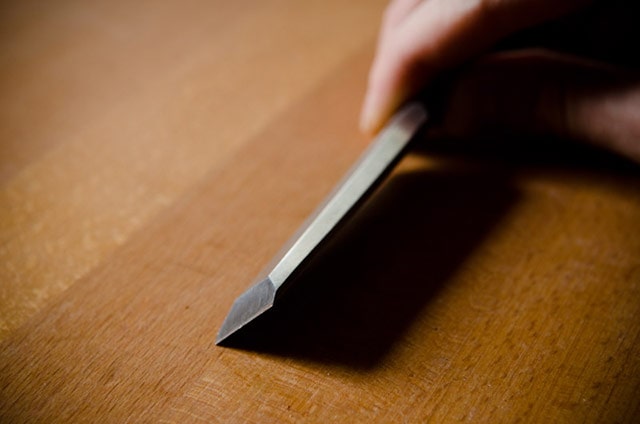
Unless you can afford a high-end set of new chisels from some of these new tool makers (Lie-Nielsen chisels, Veritas chisels, Blue Spruce chisels, Narex Richter chisels, etc.), I’d recommend that you try and piece together some antique bench chisels, in useful sizes for furniture making. Either random chisels, or matching sets. Your choice. Start off with at least four bench chisels: 1/4″, 1/2″ (or 5/8″), 3/4″, and 1″ (or 1-1/4″). I would recommend scrolling up to the section titled, “What are the Best Brands of Woodworking Chisels?” and just have fun piecing together a motley crew of high-end antique bench chisels in the sizes just mentioned. Expect to pay $10-$20 per chisel. You can also try visiting a hand tool swap (like M-WTCA). Or you can try to find (or piece together) one of my favorite vintage bevel edge chisel models:
My Favorite Vintage Bevel-Edged Chisels: Stanley 750 Bench Chisels
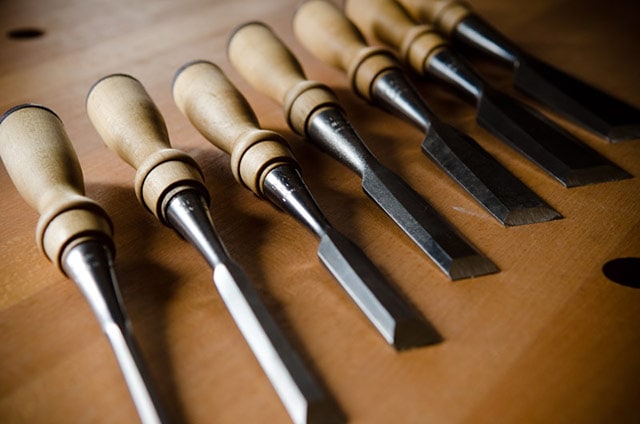
If you are determined to purchase a matching set of bench chisels, one of my favorite antique chisels are the Stanley 750 chisels, which feature beveled edges. Years ago I pieced together seven antique 750 chisels for this set: 1/4″, 1/2″, 5/8″, 3/4″, 1″, 1-1/4″, and 1-1/2″. Buying a 1/8-inch chisel is also really useful if you can find one for a decent price. 1/8-inch Stanley 750 wood chisels are rare and somewhat expensive, so get another brand if you can’t afford a Stanley 750 version. You can certainly get along with fewer than seven chisels to start with (perhaps four, as I mentioned above) and add more as needed on projects. Click the below links to find antique Stanley chisels on eBay:
- 1/4″ Stanley 750 Chisel
- 1/2″ Stanley 750 Chisel
- 5/8″ Stanley 750 Chisel
- 3/4″ Stanley 750 Chisel
- 1″ Stanley 750 Chisel
- 1-1/4″ Stanley 750 Chisel
- 1-1/2″ Stanley 750 Chisel
There are so many bad chisels out there (usually new chisels)…and a lot of “chisel-looking things” that I won’t even classify as a chisel. So you should really stick with well-made and proven chisel models (see my list of good chisel brand names earlier in this article). And if you can afford it, again I highly recommend finding some vintage Stanley 750 bevel-edge chisels. I love mine.
Christopher Schwarz said of the vintage (not new) Stanley 750 chisels, “Without a doubt, the out-of-production Stanley 750 chisel is one of the most well-designed cabinetmaking chisels ever made. The tool is finely balanced and comfortable for both paring and chopping – a rare quality in a chisel of any vintage. And I’ve always had a fondness for the long-term durability of its socket chisel design.”
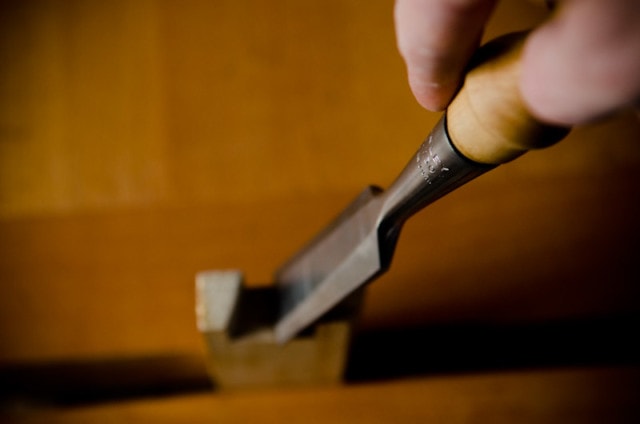
If you decide to purchase Stanley 750 bevel-edge bench chisels, you can easily piece together different sizes (with handles) on eBay like I did. I found it easier (and cheaper) to purchase, on eBay, a lightly rusted (but not pitted) set of seven Stanley 750 chisels without handles. Then you can either turn your own handles or make them with a draw knife. But I went the simpler route and bought some beautiful (yet affordable) maple handles from this craftsman who sells his handles on eBay:
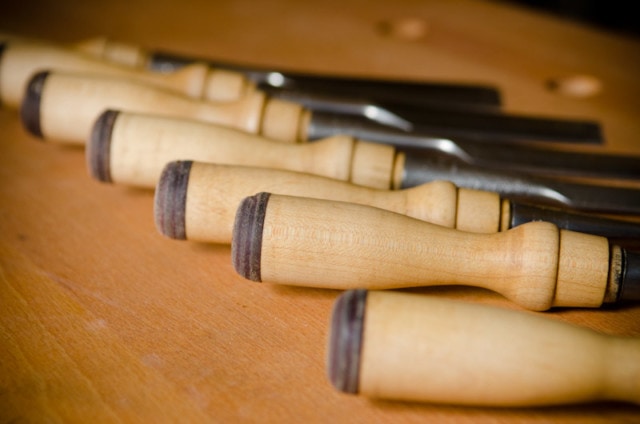
He turned the handles with leather pads on top to mimic the original maroon colored Stanley 750 handles. I had to shape them a bit on the lathe, but you can do it with sandpaper.
The Best New Wood Chisels? Narex Richter Extra Bevel Edge Chisels

Czech tool maker Narex recently released a new chisel set to the hand tool woodworking world called the Narex Richter chisels. Many woodworkers are hailing the Narex Richter chisels as the best wood chisels on the market. Many are even saying that this Narex chisel set surpasses the Lie-Nielsen chisels (see below) and the price is lower too. I have a set of 7 Narex Richter chisels and they are really nice. The prices have risen substantially since the COVID-19 pandemic, so you can compare prices at these retailers:
- See the Narex Richter chisels at Amazon
- See the Narex Richter chisels at Taylor Toolworks
- See the Narex Richter chisels at Highland Woodworking
The Narex Richter chisels have a nice balance between maintaining an edge, but not being too hard. These chisels are forged from high quality Cr-V steel and cryogenically treated and tempered to at least 62 HRc. I like the thin sides that makes it easier to get into tight spaces. The handles are ash, which is nice, but they don’t offer much grip, like an octagonal handle would. Not a big deal. I’ve found the edges to hold pretty well, but I still want to give these a few more months of use with my woodworking students before I can give a big thumb’s up.
Lie-Nielsen Bevel Edge Bench Chisels. Worth the price?

Lie-Nielsen Toolworks makes a line of nice bevel edged bench chisels, patterned after the popular Stanley 750 chisels that I mentioned above. They’ve gotten really popular, but they do have their drawbacks. For one, I don’t like A2 steel. A2 steel does hold an edge a bit better, but it makes for much harder honing. And you’ll have to invest in water stones, because I haven’t had much luck with oil stones or sandpaper. That sucks, because I like to sharpen chisels right in my workshop with oilstones and honing oil, rather than having to go find a sink. Another drawback is that the Lie-Nielsen chisels are some of the most expensive on the market, at $55 per chisel, plus expensive shipping.
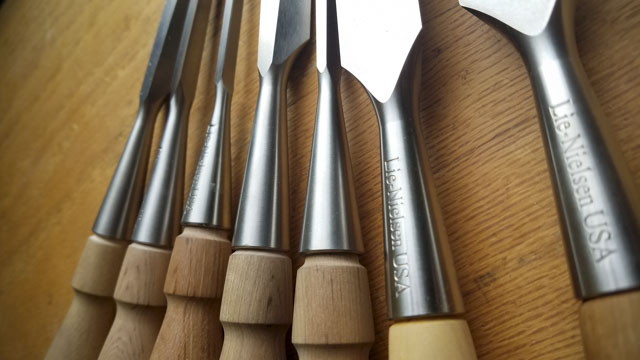
I still prefer O1 high-carbon steel, the steel found in vintage chisels. And as mentioned above, I’m still testing out Cr-V steel. Here are the buying options for these Lie-Nielsen woodworking chisels:
- Buy chisel sizes separately (1/8″-1″)
- Buy set of 5 chisels (3/16″, 1/4″, 3/8″, 1/2″, 3/4″)
Inexpensive New Bench Chisel Option:
I have tested a lot of wood chisels with feedback from my woodworking students. Some of the lower priced wood chisel sets may work alright for you, if you keep them stropped on a leather strop every couple minutes of use. Here are a few quite affordable options for wood chisel sets that I’ve tried out:
Narex bench chisels
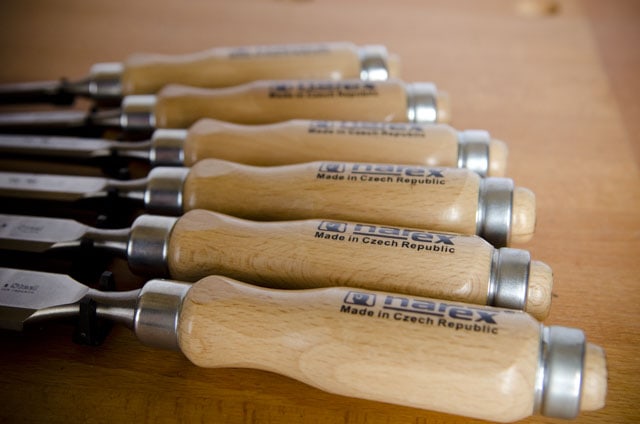
Years ago I bought a Narex 6-piece bench chisel set to try out as a cheaper option for my readers. I bought it because Fine Woodworking Magazine contributor Chris Gochnour recommended them as a best value set. Read more here. I liked these chisels, but not as much as my antique chisels, like my Stanley 750 chisels. They hold an edge longer than the Irwin chisels mentioned below, but not as long as many of my antique chisels. However, that won’t be a huge issue if you are diligent at using a leather strop quite often (every couple minutes of use). And at $12 per chisel (update: now $15/chisel) the price is right. These chisels have a nice traditional look and feel with wooden handles.
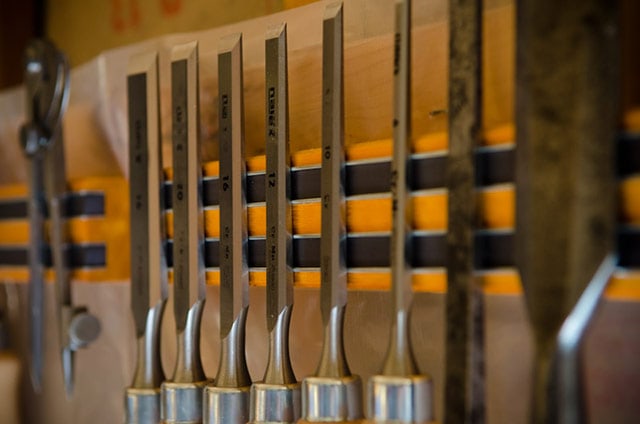
These aren’t even close to the nicest chisels I’ve used, but they aren’t bad for someone on a budget.
Irwin Marples bench chisels
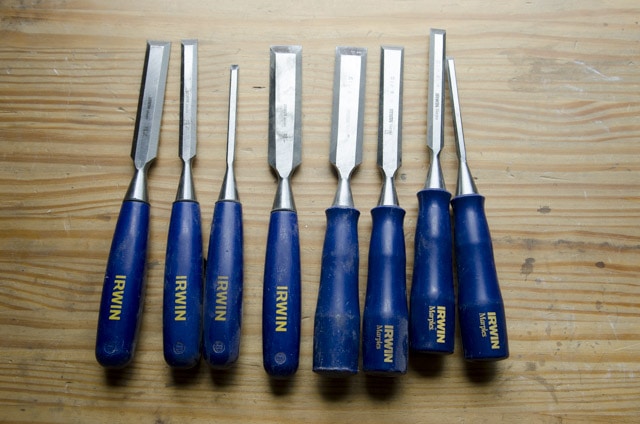
If your budget is really limited, then you can try this set of four Irwin Marple bevel edge chisels on Amazon. I own a couple sets of these chisels (I purchased them for my sons), and they work pretty well….not perfect, but good enough for beginners. The edge doesn’t last as long as any of the above-mentioned bench chisels, but again, if you strop really often, then you may get by. Currently they cost about $10 per chisel.
Buy One or Two Mortise Chisels
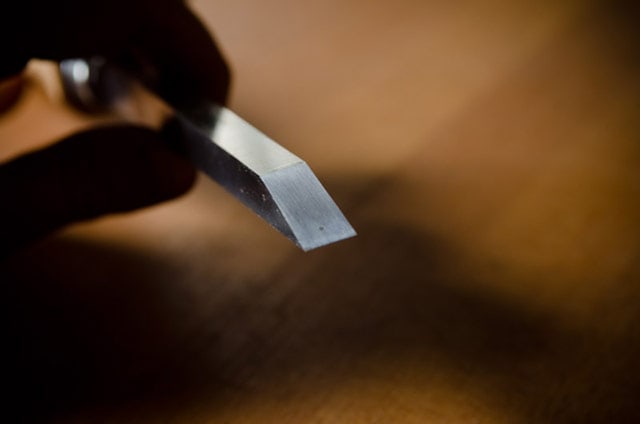
Mortise chisels (or “mortising chisels” or “mortice” chisels as they’re spelled in Britain) are used for “chopping” out mortise joints. They take a real beating, so they need to be tough. But many hand tool woodworkers opt for a weaker mortise chisel without even knowing it.
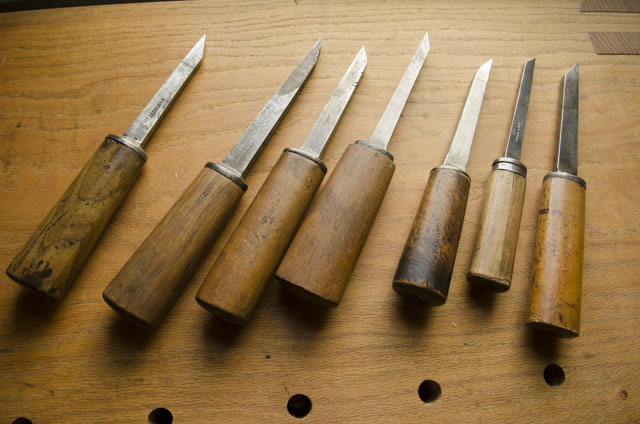
My favorite (and the toughest) chisels are traditional English “Pig Sticker” chisels. They are much stronger than the smaller and weaker “Sash” mortise chisels that are carried by most modern manufacturers, including Lie-Nielsen Toolworks (see the Lie-Nielsen “sash” mortise chisels here).
Antique Pig Sticker style mortise chisels are what we predominantly use in my traditional woodworking school, because they can take a beating, because they are more comfortable in the hand (due to their oval shaped handle), and because they don’t roll off the workbenches (again, due to their oval shaped handle). Oh yeah, and they’re more affordable than most other mortise chisels. Go figure.
Some people feel that the tang handles on a Pig Sticker wood chisel can split easier than socket chisels (yes, I’ve seen some split handles), but I have yet to split a handle on one of my Pigsticker mortise chisels. However, replacing the handle isn’t incredibly difficult.
Chris Schwarz and Peter Follansbee love the classically revived English “Pigsticker” mortise chisels made by Ray Iles in Sheffield, England. Read Peter’s review (here). They’re sometimes available at Tools for Working Wood here for around $70 each, $80-$130 each, although they’re often sold out of popular sizes. This confuses me, however, because the price of the new Ray Iles chisel is three times that of the beefier antique pit sticker chisels. That’s why I’ve bought so many antique English mortise chisels for my woodworking school.
Jim Bode Tools has the best selection of antique Pig Sticker mortise chisels. As of the writing of this article, most are about $36 with free shipping. Here are some links to vintage mortise chisels for sale:
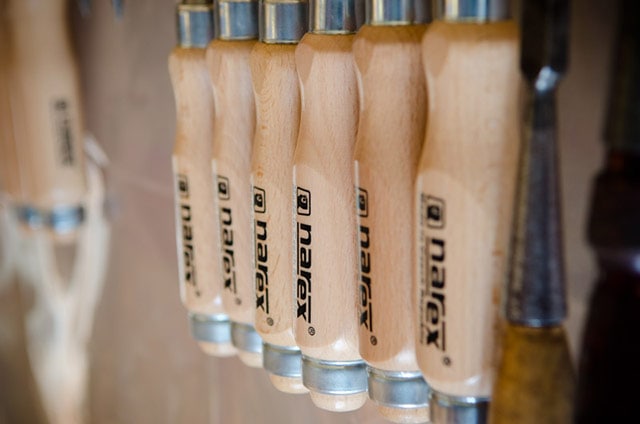
I also purchased several new Narex Mortise Chisels for my school. However, I haven’t been terribly impressed by them. They are somewhat affordable, but for some strange reason I get constant complaints from students about how these mortise chisels tend to twist in the hand when the mallet hits it, causing the mortises to expand. I have found the exact same problem when I use them, and I really haven’t been able to figure out what is causing it. Also, the tool steel seems to be too soft for a mortise chisel. The edges are constantly turning over.

Also, you most certainly won’t need to purchase a whole set of mortise chisels. My favorite mortise chisel size is 3/8″… not too small and not too big. I also use a 1/4″ mortise chisel on occasion (5/16″ is a good substitute for 1/4″). 3/8″ and 1/4″ mortise chisels work great with standard board thicknesses of 3/4″ or 7/8″.
RELATED
Which 20 Woodworking Hand Tools Should You Buy First?
Why Traditional Hand Tool Woodworking?
10 Jaw-Dropping Woodworking Shop Tours
57 Page Moravian Workbench Plans Now for Sale
How to Make a Mortise and Tenon Joint with Woodworking Hand Tools
8 Steps to Cutting Dovetails with Woodworking Hand Tools
B. Semi-Urgent Wood Chisels (Buy these next)
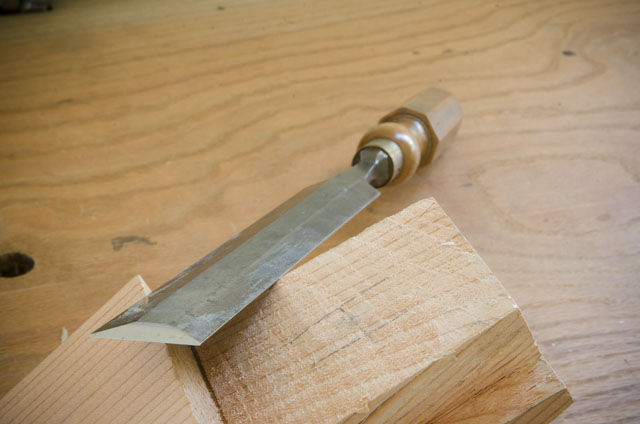
This is a list of basic hand woodworking tools that are very useful, but that may not be absolutely necessary for beginner’s projects. But they might, depending on what you’re building!
Buy a Paring Wood Chisel
Paring chisels are used for fine paring (or hand trimming) of joints. You can pare with normal bevel edge chisels, but paring chisels can help with creating smoother joints. They are typically longer, thinner, and are sharpened at a lower angle than other chisels (around 20 degrees), which enables you to trim end grain with greater ease. However, with a 20 degree angle and thin steel, they should never be used with a mallet. They can have a bevel or no bevel.
You’ll be pretty safe buying most of the brands mentioned in the list of wood chisels above (e.g. Stanley, Swan, Witherby, Buck Bros, Blue Spruce, etc.). The size of paring chisel you buy will depend on what you’re building. I really love my classic 1/2″ Witherby paring woodworking chisel. It has amazing steel, and sharpens nicer than most wood chisels. But more common sizes are around 1-inch. I recently got a set of Narex paring chisels that I’ve been testing out, and they seem to work quite well.
C. Non-Urgent Wood Chisels (Buy these as needed)
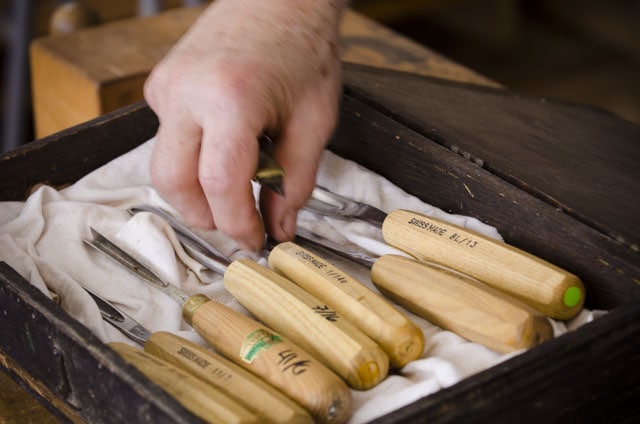
Below is a list of some non-urgent specialty chisels & accessories. You may find that you eventually need them, but you won’t need them for getting started in traditional woodworking.
Buy Wood Chisel Accessories
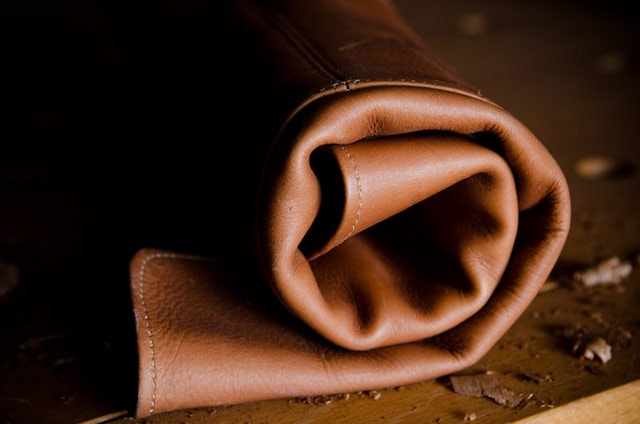
I’ve really loved having a good sturdy leather chisel roll to hold my wood chisels when I travel, or even in the workshop. It protects the chisels edges & chisel handles, but also protects everything else from your chisels!
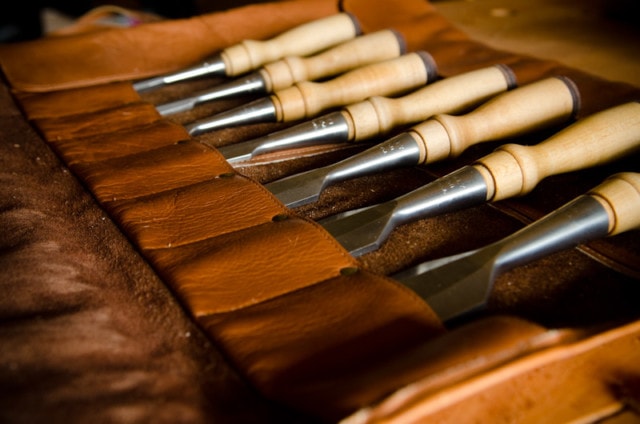
Plus, it’s a really beautiful way to display your nice chisels. I purchased my “Large Deluxe Leather Chisel Roll” online from Highland Woodworking and am very satisfied with it. It was $25 cheaper than the Lie-Nielsen tool rolls, and may actually be higher quality from what I can tell.
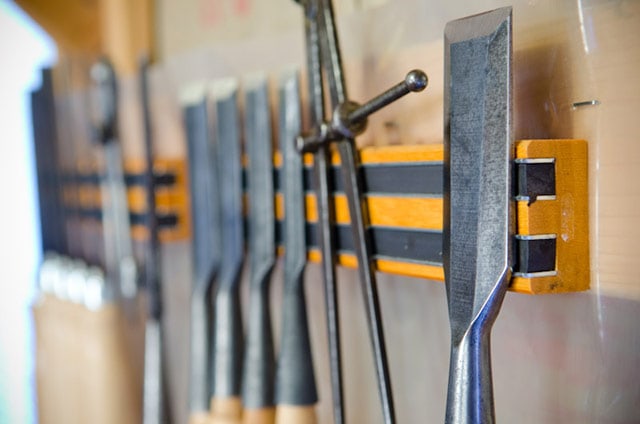
Another chisel accessory that I’ve found very convenient is a magnetic tool holder. I bought two 12″ magnetic tool holders from Highland Woodworking (I wanted to stack them vertically) for around $8. But you can also purchase a 24″ holder for around $15. It’s not necessary, but it is convenient to grab a chisel off the wall. You can also build shelves to hold chisels:
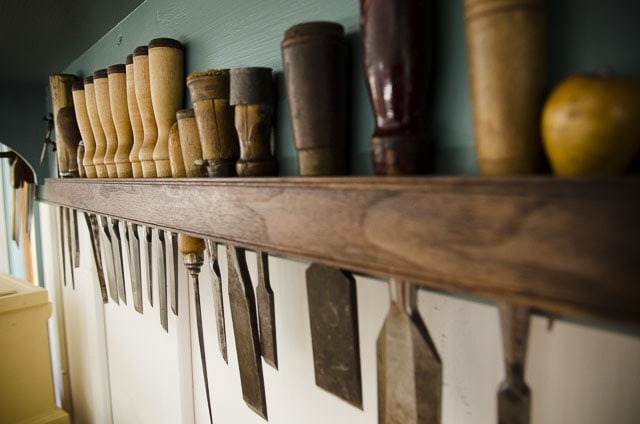
Continue to the Tool Sharpening Buying Guide (#6)…
TOOL GUIDE SHORTCUTS:

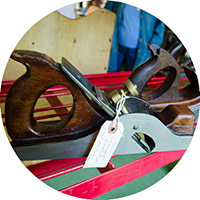
HAND TOOL BUYER’S GUIDES
- Intro to Buying Woodworking Hand Tools
- Workbench & Tool Storage
- Layout, Marking, & Measuring Tools
- Handplanes
- Handsaws
- Chisels
- Sharpening & Honing Supplies
- Mallets & Hammers
- Hand Drills, Braces, & Bits
- Tools for Curved Work
- Tools for Green Woodworking
- Woodworking Clamps, Gluing & Fasteners
- Tools for Wood Carving
- Products for Wood Finishing, Sanding & Scraping
- Wood Turning Tools & Lathes


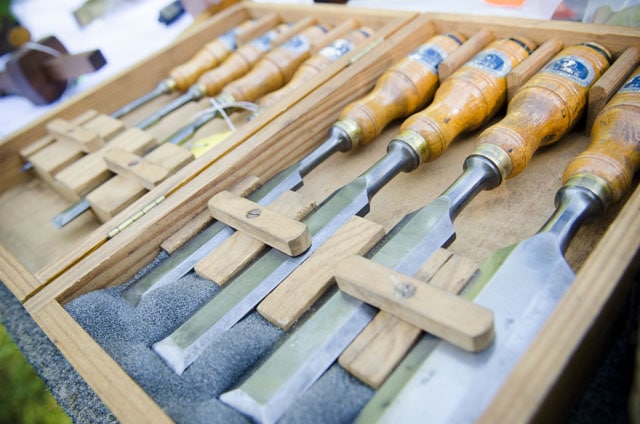

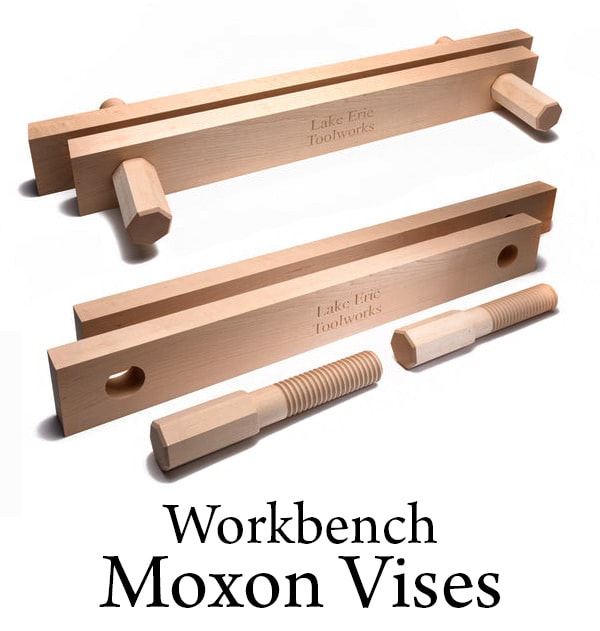
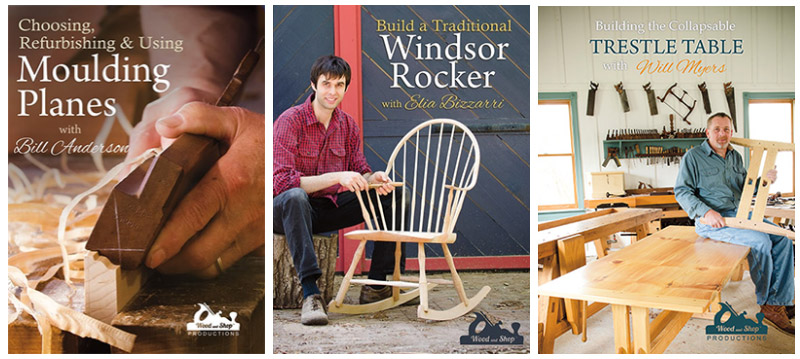
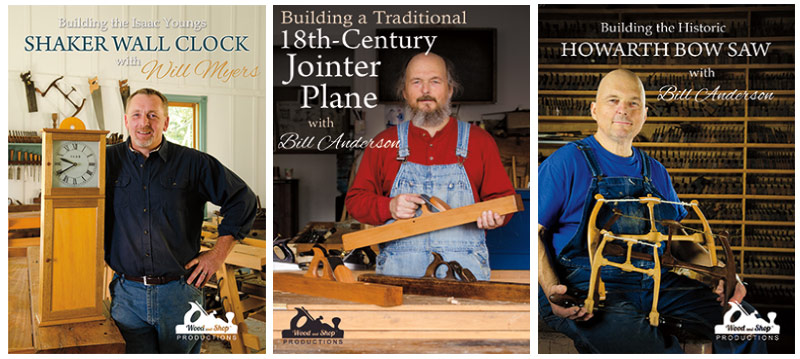
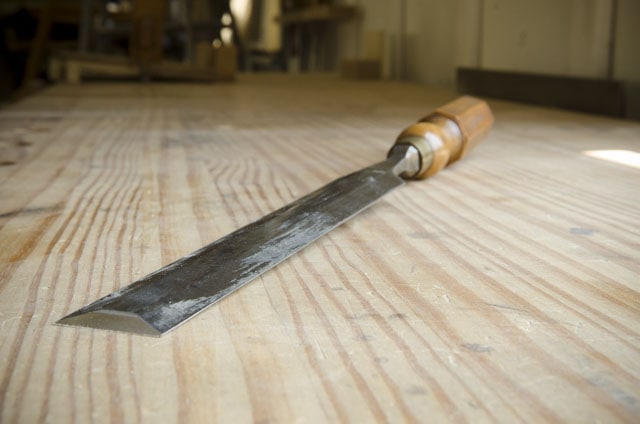
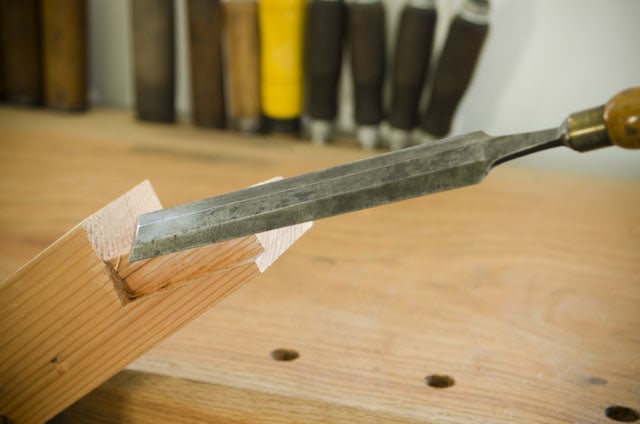
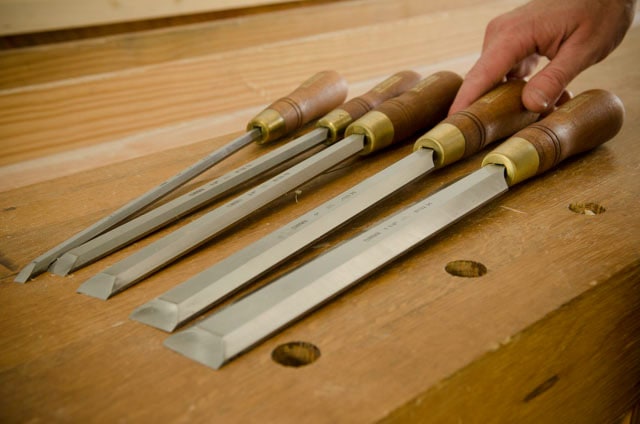
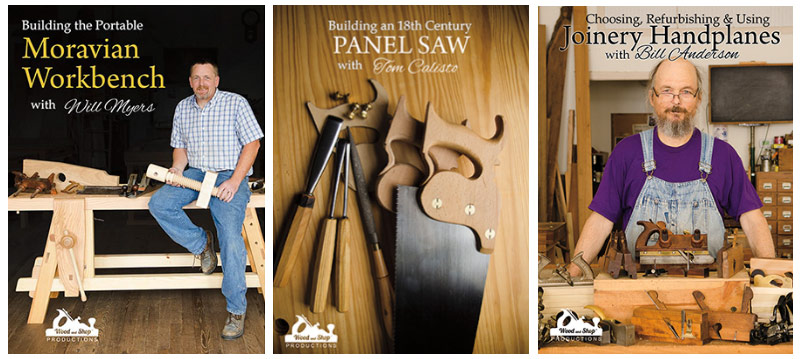
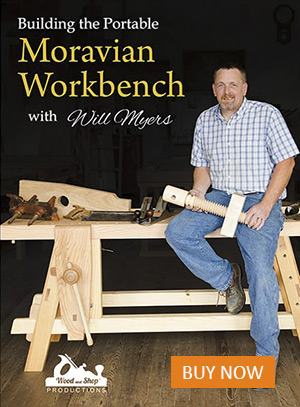
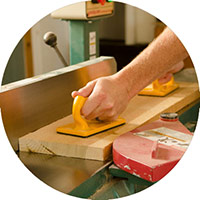
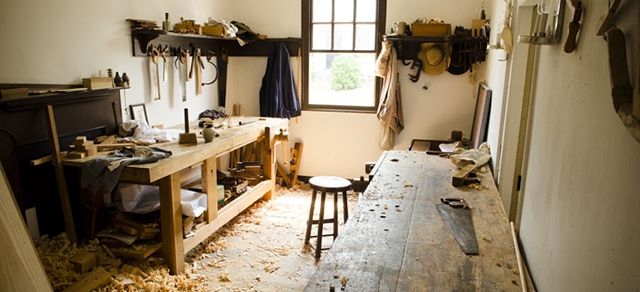
Great article. Helped me in finding some older chisel and what to look for. This was the first article that I read in your website and decided to subscribe. First choice Shaker Candle Stand, Berock black plane mug. Alabama in the good ole US of A.
Thanks, Joshua! This article was instrumental in my process of acquiring a collection of chisels for my start in handtool woodworking. Just an understanding of what to look for has helped me make informed decisions when checking out vintage chisels, my preferred source. I still need to restore them all, though… now where did I put that bucket of elbow grease? Here are my giveaway choices: Video: Shaker Candle Stand T-shirt: the Disston Saw Medallion I live in Orlando, Florida… Read more »
This was a much needed, well written, and very informative tutorial. I am just getting into wood working, so this was very good to read. I will make my way through your other videos and web pages on learning more. Thank you for this information. I would like to get some medium priced chisels…and despite your well written article, I would rather have a specific chisel to get. Can you give me a good chisel that I can get? I… Read more »
What’s your budget for chisels? “Medium” is a relative term, so if I know a dollar amount I can help you out.
Nice list of Anglosaxon (!) chisel types and makers. I like your work and listings, but they are almost totally Anglosaxon oriented. There actually is a whole world out there…
You’re correct, but because I learned on western style tools, that’s what I use. And that’s what I know how to sharpen & use. I’m sure Asian chisels are wonderful, but they aren’t as readily available here in the U.S. as western-style.
Thanks Josh!
You’re welcome Tassos! How is Greece doing these days?
Hi,
Great article, but I missed the brands to avoid?
Also, 2 Cherries are a fantastic German manufacturer. Affordable too.
Hey Johnny,
I try to not spread bad press on other companies. But Two Cherries sent me some chisels a couple years ago and I wasn’t impressed. Not sure about the older ones.
Have you ever used any vintage Keen Kutters?
Yes, I have one or two old ones.
Thanks for the information Josh. I’m looking to invest in my first set of bench chisels and I’ve come across two sets by Footprint: 565 and 86 series. Any experience or opinions with Footprint chisels? My research seams to suggest they are a “budget chisel” with Sheffield steel; no longer in production. Appreciate your time and sage advise.
Sorry, but I’ve had no experience with these chisels. I’m sure they’ll work fine if you keep them stropped every couple minutes of use.
Are the Veritas PM-V11 chisels worth the money? I’m trying to choose between them and the Lie Nielsen ones when I upgrade my bench chisels. I’ve become disenchanted with my Mifer chisels. They were what I could afford in the mid 1980’s. Many thanks and keep up the great work on your website!
I haven’t tried them, but I’ve been told that these new Narex chisels are as good as Lie-Nielsen: https://bit.ly/2Sm7cIQ
I just read in “The Anarchist’s Tool Chest” by Christopher Schwarz that they require diamond stones to sharpen. I’m all set up with water stones and will likely go with Lie Nielsen’s chisels.
Thanks and love your website.
Great setup Wes!
Interesting article, Joshua – thanks!
If I can suggest a couple of other brands: Lee Valley’s Veritas chisels (especially those in PM-V11 steel, which really does need sharpening less often), and in vintage chisels the Swedish firm EA Berg.
Thanks Evan! But I already had those two brands on the list :)
Do you have any opinion about the Stanley sweetheart chisel set? I looked on eBay for some blades like you recommended but the options are limited. Thanks for your input. Love the website. Top notch!
I don’t own those chisels, but my friend does, and he says they are just “okay”. There’s a new set of affordable chisels that are getting a lot of attention: https://bit.ly/2Sm7cIQ
Hi i was wondering i you have ever used any tools made by Bahco? It is a swedish company. I have used their saws and found them to be higher quality than other new saws by average hardware store brands. I recently saw their chisel sets ; not cheap, online. I would be interested in your opinion on Bahco tools. Many people i ask have never heard of them, but i found some random pieces at a local Ace hardware… Read more »
Sorry Andrea, I haven’t heard of them.
just starting out. I hope to read all of your guides as I begin my journey into woodworking. Still unsure about hand tools, especially chisels. I have a very limited knowledge, only one class when I was in 8th grade and that was a long time ago. I also did not do well I was extremely insecure about the whole thing. I guess the best thing to do is buy some hand tools and start using them. We currently have… Read more »
Hi Cathy, you’re right, just buy a few tools and start building something, and don’t worry if it looks terrible! That’s how to get better really fast.
Hi my name is Shawn I live in Canada In Cold Lake Alberta. Since I was a young boy I always been fascinated and loved the ways of wood working. Much because of my disability in reading and writing. I Never Gain a certification in Wood Working. Finally now in my age of 34 I am finally Able to give this dream of mine A chance. But now I am trying to find the tools in the skills to fully… Read more »
Welcome Shawn, and glad to hear that you’re getting into woodworking!
Like to know who made this ..
Have a set of 12 chisels with this inscription on it.
Can’t help you there Jason. But if you find out, please come back here and let me know. It looks like a newer brand.
Those are German J. A. Henckels. You may be familiar with their kitchen knives, they are popular in the culinary world and known for quality knives.
This was a fantastic article for those of us just starting out, thanks Joshua!
I’m curious why there was so much specificity on brand and quality with the bench chisels and basically none with mortise chisels other than to get an old one that has the pig sticker type handle.
Were all the old ones great? Does chisel material not mater with the type of work being done on mortise joints? Why such selectiveness only for bench chisels??
Great article Joshua! This was extremely helpful as someone completely new to any form of wood working. Quick question – You are ver specific about brands of bench chisels but when it came to mortise chisels it seemed like anything old with a pig sticker handle was good enough. Why so much less specificity? Are the way those chisels used just not as important? Are all old mortise chisels just that much better? Is it simply handle shape? Thanks for… Read more »
Thanks Hank! Pig sticker chisels are much harder to find than normal bench chisels, and every antique pig sticker mortise chisel I’ve bought (about 10 now) has worked great. And most don’t have a brand name on them. Cheers!
I am sorry to be the guy who asks the really obvious questions. Am I correct in thinking that the basic reason that buying chisels is such mine-field is that hard-steel and soft-steel look pretty much the same? Assuming that is true, and that we want as hard as possible, does that mean that a file will mark a bad chisel, but skate from a good one? Are chisels generally the same hardness all the way through? Though, maybe that… Read more »
It’s kind of hit and miss with modern chisels, so you need to ask others for advice. But I’ve found that most vintage chisels have a pretty good balance between hardness and softness. Not too hard so that it breaks off, and not too soft so that the edge turns over. Most manufacturers back then seemed to have the right recipe!
Hi Joshua! I really appreciate the generous nature of your wealth of knowledge. I was wondering, like I’ve heard about plane blades, like bobbert mentioned, if the hardness of the chisel is consistent throughout the length. I have a couple old Stanley 750s I found that seem to have had their bevels reground many times, but are in rough shape currently. Can I regrind the bevel again (and again?) and not worry that I’ll be getting into softer steel? If… Read more »
Hello Michael, you should be fine with Stanley 750 chisels. They have consistent steel all the way through.
Joshua, thank you for a great article. I feel like I’m listening to a very knowledgeable and trusted friend. Tom from Williamsburg, VA.
Thanks so much Tom! Glad to hear from a new friend in Virginia!
What a great article Joshua, just out and the comments are overflowing! Hope you have time to consider mine. I have two questions: 1) you mention “frequent stropping” in passing but don’t really discuss why this is important. Is this for all your chisels or just for the “cheaper” ones. Do you strop on leather glued to a board or using a buffing wheel? What stropping compound do you recommend? There are other gurus that seem to always finish their… Read more »
Hi Gordon, I’m happy to answer your questions: 1. I strop all of my chisels, because it keeps them all from getting dull. This is a habit that saves me a lot of sharpening time. I stop on a piece of leather glued to a board. I just use some cheap high polishing compound that I bought at Lowe’s years ago. It lasts a very long time. The stropping is bascially honing at a very fine grit (there’s grit in… Read more »
I have had no problem using oil stones to sharpen my L-N bench chisels. I’ve also used Shapton diamond plates and a Tormek wheel and buffer. Razor sharp with ease.
thought I knew a bit about chisels, after reading this article, found I knew very little…..thank you
Ha! We all should keep learning Don!